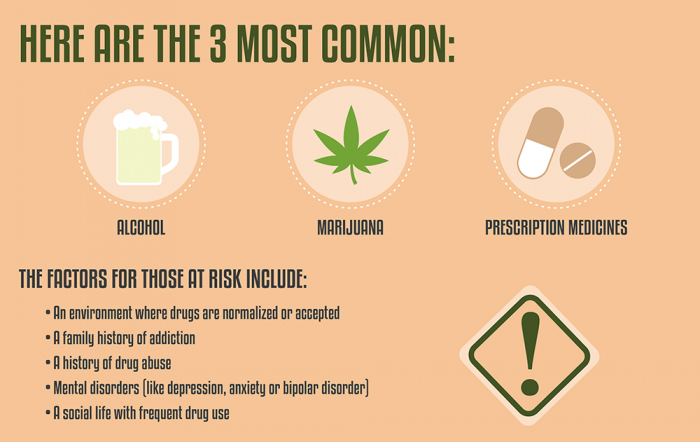When people first hear the term “gateway drug” most people probably think of marijuana, but other common examples include, alcohol, nicotine, and prescription drugs. These are all substances that can increase your probability of further drug use.
Most people do not wake up in the morning and impulsively decide to try heroin, cocaine or other hard drugs. There is a gradual exposure to addictive substances, people, and environments which lead to heavy drug use and addiction. A study between 2001 and 2004 said that marijuana use significantly increases the chance of abusing opioids later in life. Another research article by Yale in 2012 also said that marijuana users are 2.5 times more likely to abuse prescription medicine. While marijuana use is generally accepted in society, it chemically sets up the brain for addiction later in life. I will further investigate the chemical changes in the brain by marijuana to highlight its gateway properties.

Fig. 1: A list of the three most common gateway drugs and additional risk factors for addition
Background on Addiction: Reward Pathway
All drugs are known to affect the brain’s natural reward pathway. This circuit begins in the ventral tegmentum area (VTA) of the midbrain and projects to cells of the nucleus accumbens (NAc) where the neurotransmitter dopamine is released (Fig. 2). An Increased amount of dopamine in the NAc is associated with the euphoria like feeling you get when you do pleasurable things like eating dessert, having sex, or taking drugs. Evolutionarily, the pathway’s purpose is to reinforce behaviors that are beneficial to survival. However, drugs overstimulate and abuse this circuit causing long-term changes in the brain including tolerance and withdrawal. There also is the formation of incredibly strong memories that make it hard for drug users to disassociate familiar environments and people from the urge to use drugs.

Fig. 2: An overview of the Reward Pathway
Gateway Drugs and their Role in Addiction
Marijuana, like every other addictive drug, increases the amount of dopamine in the NAc and activates the reward pathway. However, chronic use of marijuana can actually reduce the size of cells in the VTA which leads to reduced function. The reward pathway is then impaired resulting in less dopamine in the NAc and therefore, tolerance of the drug. Tolerance is then a slippery slope because people start experimenting with higher doses or new drugs to feel the same euphoric effects. The shrinkage of VTA neurons is also directly related to their hyperexcitability when in the presence of morphine. The smaller cell size decreases the number of cell proteins required for inhibitory mechanisms resulting in hyperexcitability of the VTA and increased euphoria. These mechanisms explain why Marijuana users are more likely to abuse prescription painkillers or experiment with other drugs.
Now What?
While this blog focused on marijuana, other gateway drugs such as nicotine, alcohol and prescription drugs follow some of the same concepts to elicit drug abuse. This is a considerably important topic with the legalization of marijuana now in 10 states across America. It is crucial to know that while drugs like marijuana and nicotine are legal to use, it does not mean that they have no consequences. It is also is important to state that gateway drugs do not condemn a person to drug abuse since many factors like genetics and exposure very between people. As a final remark, it is crucial for the public to be aware of the risk factors associated with gateway drugs since they do generate long-term changes in the brain.
Sources:
http://webcache.googleusercontent.com/search?q=cache:http://www.castri.org/Cannabis-Opioids.pdf
https://www.drugabuse.gov/news-events/nida-notes/2018/03/why-marijuana-displeases
